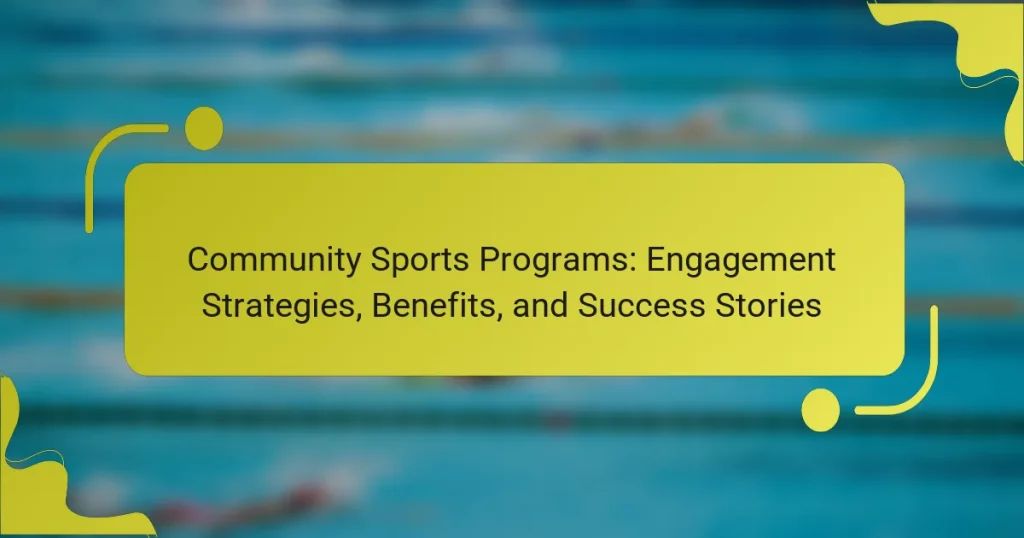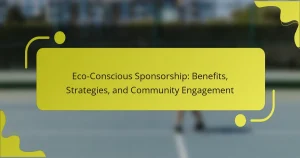Community sports programs foster engagement and build strong community ties. Key strategies include promoting inclusivity, leveraging social media, and empowering local leadership. These programs provide benefits such as improved physical health, social connections, and teamwork skills. Successful initiatives, like Harlem RBI and Girls on the Run, showcase the positive impact of community involvement and effective engagement strategies.

What are the key engagement strategies in community sports programs?
Key engagement strategies in community sports programs include fostering inclusivity, promoting local leadership, and leveraging social media. These strategies enhance participation and build strong community ties.
Inclusivity ensures that programs cater to diverse populations, addressing varying skill levels and backgrounds. Local leadership empowers community members to take ownership, which boosts motivation and sustainability. Social media serves as a powerful tool for outreach, creating excitement and fostering connections among participants.
Incorporating feedback mechanisms helps adapt programs to community needs, ensuring relevance and engagement. Additionally, partnerships with local organizations can enhance resources and visibility, driving greater participation.
How can local partnerships enhance program participation?
Local partnerships can significantly enhance program participation by fostering community engagement and resource sharing. Collaborating with local businesses, schools, and organizations creates a network of support that attracts participants. These partnerships can provide facilities, funding, and volunteers, increasing program visibility and accessibility. Additionally, they help tailor programs to meet community needs, ensuring relevance and encouraging broader involvement. Engaging local stakeholders cultivates a sense of ownership, motivating individuals to participate actively.
What role does technology play in engaging community members?
Technology enhances community engagement in sports programs by facilitating communication, promoting events, and fostering connections. Digital platforms enable real-time updates and feedback, making participation more accessible. For instance, mobile apps can streamline registration and provide schedules, while social media fosters community interaction. Additionally, data analytics can track engagement metrics, helping organizations tailor their strategies effectively. Ultimately, technology creates a more inclusive environment, encouraging broader participation and strengthening community ties.
Which marketing techniques are most effective for promoting sports programs?
Community sports programs benefit from various effective marketing techniques. Social media engagement, local partnerships, and community events are crucial for promotion.
1. Leverage social media platforms to share success stories and updates.
2. Collaborate with local businesses for sponsorship and support.
3. Host community events to increase visibility and participation.
4. Utilize email newsletters to inform and engage the community.
5. Create engaging content that highlights program benefits and testimonials.

What benefits do community sports programs offer to participants?
Community sports programs offer numerous benefits to participants, including improved physical health, social connections, and enhanced teamwork skills. These programs promote regular exercise, reducing the risk of chronic diseases. Participants often build friendships, fostering a sense of belonging within the community. Additionally, engaging in team sports enhances communication and collaboration skills, valuable in various life aspects. Overall, these programs contribute to personal development and community cohesion.
How do these programs impact physical health and fitness?
Community sports programs significantly enhance physical health and fitness by promoting regular exercise and social engagement. Participants experience improved cardiovascular health, increased strength, and better coordination. These programs also foster a sense of community, which can lead to sustained participation. For example, a study found that individuals involved in community sports are 30% more likely to meet recommended physical activity levels compared to non-participants. Engaging in these programs helps combat obesity and related health issues, making them vital for community well-being.
What social benefits arise from participation in community sports?
Participation in community sports fosters social benefits like improved social connections, enhanced teamwork skills, and increased community cohesion. These programs create inclusive environments where individuals from diverse backgrounds interact and collaborate.
As a result, participants often report a stronger sense of belonging and support. Community sports also provide opportunities for leadership development, as individuals take on roles that promote responsibility and collaboration.
Moreover, these activities can lead to reduced social isolation, particularly among youth and seniors, by encouraging regular interaction and engagement. Overall, community sports play a crucial role in building healthier, more connected communities.
How do community sports programs foster inclusivity and diversity?
Community sports programs foster inclusivity and diversity by creating welcoming environments for participants of all backgrounds. These programs encourage participation through accessible facilities, diverse team compositions, and targeted outreach initiatives.
They often implement adaptive sports to cater to individuals with disabilities, ensuring everyone can engage. Additionally, community sports programs promote cultural exchange and understanding by bringing together participants from various ethnicities and socioeconomic statuses.
As a result, these initiatives not only enhance social cohesion but also build friendships and networks that transcend barriers. Success stories from these programs illustrate their impact on community unity and individual growth.
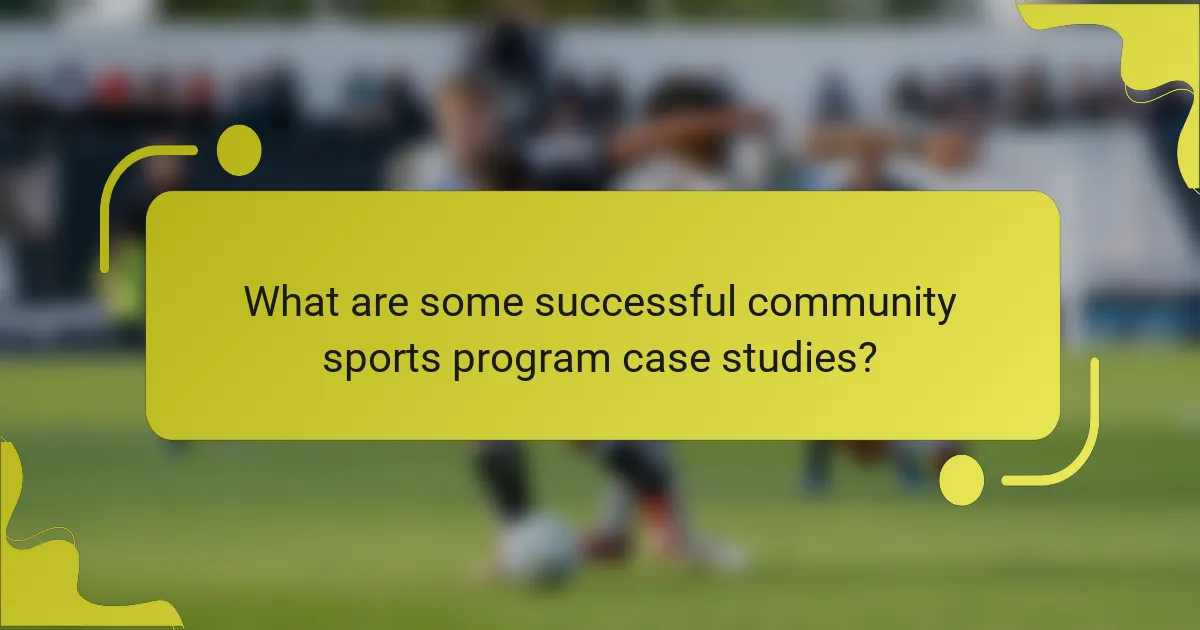
What are some successful community sports program case studies?
Successful community sports programs often demonstrate effective engagement strategies and positive outcomes. Case studies include:
1. **The Harlem RBI Program**: This initiative combines sports with education, significantly improving academic performance and fostering leadership skills among participants.
2. **Girls on the Run**: This program empowers young girls through running, enhancing self-esteem and promoting physical health while building community connections.
3. **Sports for Life**: Focused on underserved youth, this program provides access to various sports, promoting inclusivity and teamwork, and has led to increased participation rates.
4. **Playworks**: This organization transforms recess into a positive experience, teaching conflict resolution and cooperation, resulting in improved school climate and student engagement.
5. **The Special Olympics**: This global movement offers sports training and competitions for individuals with intellectual disabilities, fostering inclusion and community support.
These programs illustrate the benefits of community engagement, such as improved health, social skills, and academic success.
Which programs have significantly increased youth engagement?
Community sports programs have significantly increased youth engagement through structured activities and mentorship. These programs foster teamwork, leadership skills, and physical fitness. Successful examples include the Positive Coaching Alliance, which promotes a positive sports culture, and local initiatives like the After-School Sports Program, which offers accessible training and competition opportunities. They often report higher participation rates and improved social skills among youth participants.
How have specific initiatives improved community cohesion?
Community sports programs have significantly improved community cohesion by fostering relationships and encouraging collaboration. These initiatives create shared experiences, bridging gaps between diverse groups. For example, local soccer leagues bring together participants from various backgrounds, promoting unity and teamwork. As a result, communities experience enhanced trust and social capital, leading to lasting connections among residents. Success stories highlight increased participation rates and positive feedback from participants, showcasing the effectiveness of these programs in strengthening community bonds.
What lessons can be learned from international examples of successful programs?
International examples of successful community sports programs demonstrate effective engagement strategies and impactful benefits. Programs in countries like Australia and the Netherlands prioritize inclusivity, ensuring diverse participation. For instance, Australia’s Active After-school Communities program increases youth engagement through structured activities, fostering social skills and physical health. Similarly, the Netherlands’ Sport for Everyone initiative emphasizes accessibility, providing resources for underrepresented groups. These programs show that tailored approaches, community involvement, and sustained funding lead to success. Adopting similar strategies can enhance local initiatives, promoting long-term community engagement and well-being.
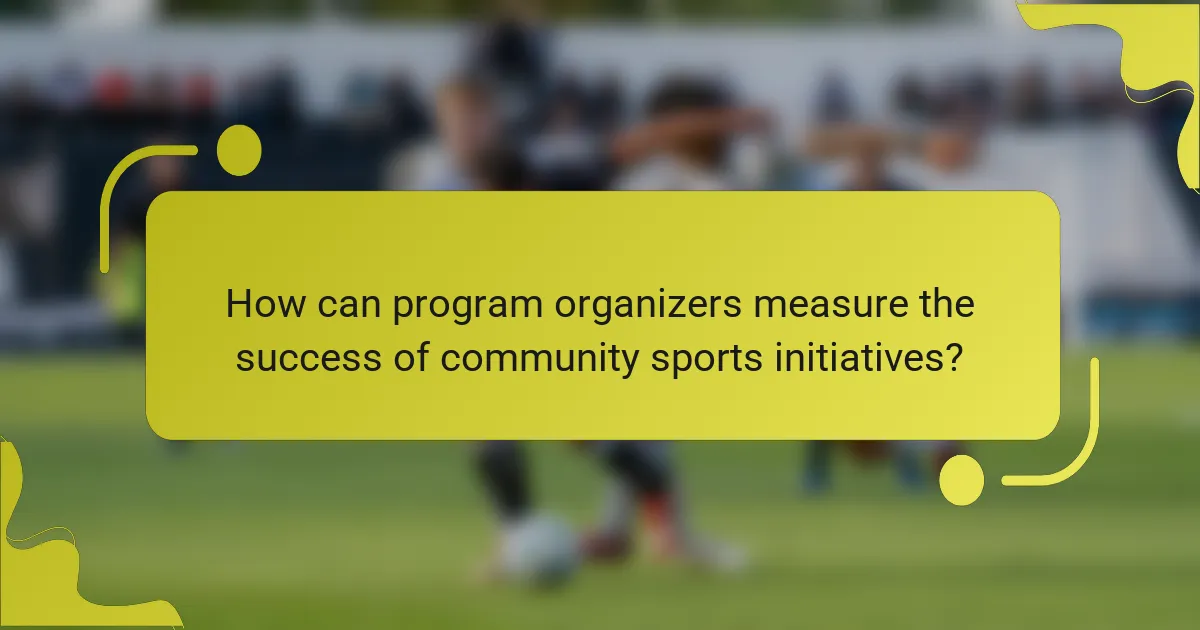
How can program organizers measure the success of community sports initiatives?
Program organizers can measure the success of community sports initiatives through participant feedback, attendance rates, and community engagement levels. Tracking metrics such as the number of active participants and retention rates provides insights into program effectiveness. Additionally, evaluating community partnerships and sponsorship involvement reflects broader support and impact. Success stories highlighting personal achievements and community benefits further illustrate program outcomes.
What metrics are essential for evaluating participant satisfaction?
Essential metrics for evaluating participant satisfaction in community sports programs include participant feedback, retention rates, engagement levels, and program accessibility. Collecting qualitative data through surveys helps gauge satisfaction, while quantitative measures like attendance and repeat participation provide insights into overall program effectiveness. Analyzing these metrics allows program coordinators to identify strengths and areas for improvement, enhancing participant experiences.
How can community impact be assessed through sports programs?
Community impact can be assessed through sports programs by measuring participation rates, social cohesion, and health improvements. These programs often foster community bonds, promote inclusivity, and enhance overall well-being. For example, a study found that neighborhoods with active sports initiatives reported a 30% increase in community engagement. Additionally, success stories highlight how local sports events can reduce crime rates and improve youth development. By analyzing these metrics, stakeholders can gauge the effectiveness of sports programs in enhancing community life.
Which tools and methods are effective for tracking progress and outcomes?
Effective tools and methods for tracking progress in community sports programs include surveys, participant feedback, and performance metrics. These tools enable organizations to assess engagement and outcomes systematically.
1. Surveys: Collect quantitative and qualitative data on participant satisfaction and program impact.
2. Participant Feedback: Gather insights through interviews or focus groups to understand experiences and areas for improvement.
3. Performance Metrics: Monitor attendance rates, skill development, and health improvements to evaluate program effectiveness.
4. Data Analytics: Utilize software to analyze trends and outcomes, enhancing decision-making and strategy adjustments.
These methods provide a comprehensive view of program success and participant engagement.
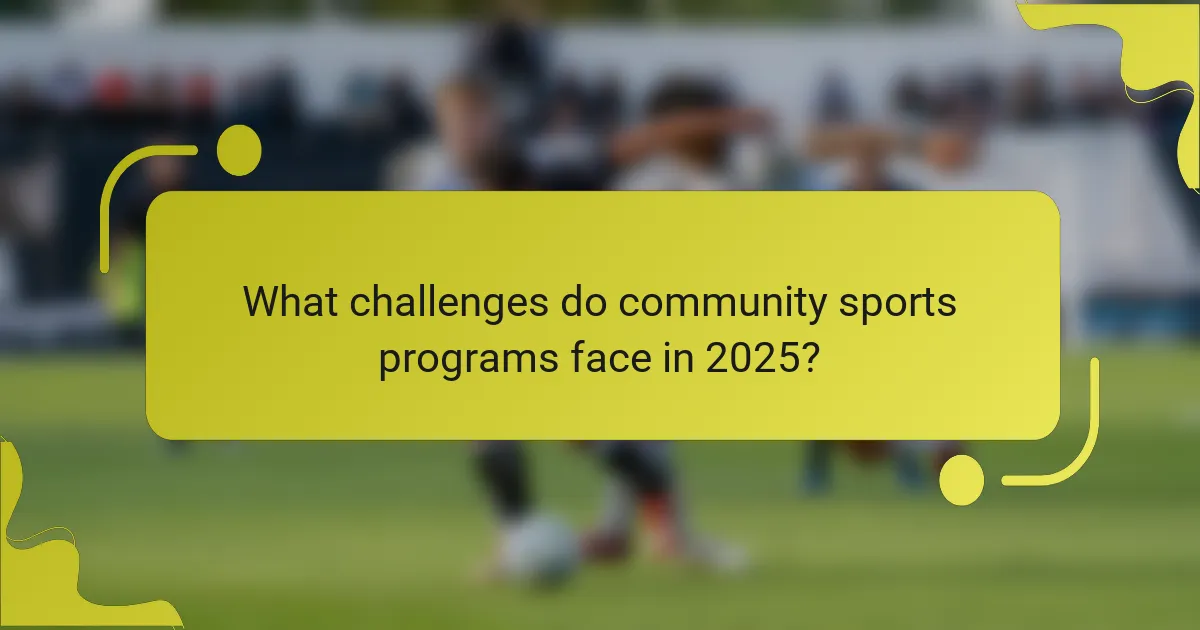
What challenges do community sports programs face in 2025?
Community sports programs in 2025 face challenges such as limited funding, participant engagement, and resource accessibility. These factors hinder program sustainability and growth. As a result, organizations must innovate strategies to attract diverse participants and secure financial support. Technology integration can enhance engagement, while partnerships with local businesses may provide essential resources.
How can funding limitations affect program sustainability?
Funding limitations can significantly hinder program sustainability by restricting resources needed for operations. Insufficient funding affects staffing, equipment, and facilities, leading to reduced program quality and participant engagement. Programs may struggle to retain skilled coaches and staff, which diminishes the overall experience for participants. Additionally, limited financial support can hinder outreach efforts, reducing community awareness and participation. As a result, programs may face challenges in maintaining consistent schedules and offerings, ultimately threatening their long-term viability.
What are common barriers to participation in community sports?
Common barriers to participation in community sports include lack of access, financial constraints, and limited awareness of programs. Transportation issues often prevent individuals from reaching facilities. Additionally, time constraints due to work or family commitments can hinder participation. Cultural or social factors may also discourage involvement, particularly in underrepresented communities. Addressing these barriers can enhance engagement and promote inclusivity in community sports programs.
How can organizers address issues of retention and engagement?
Organizers can enhance retention and engagement by creating inclusive environments, offering diverse activities, and fostering community connections. Tailored communication strategies also play a crucial role in keeping participants informed and motivated.
To achieve this, focus on the following strategies:
1. **Inclusive Programming**: Design activities that cater to various skill levels and interests.
2. **Community Building**: Encourage social interactions among participants through team-based events.
3. **Feedback Mechanisms**: Regularly solicit input to understand participant needs and preferences.
4. **Recognition and Rewards**: Implement systems to acknowledge achievements and milestones.
5. **Consistent Communication**: Use newsletters and social media to keep participants engaged and informed.
These approaches foster a sense of belonging and commitment, leading to higher retention rates in community sports programs.
What innovative solutions have emerged to overcome these challenges?
Innovative solutions to challenges in community sports programs include technology integration, partnerships with local businesses, and tailored engagement strategies. These approaches enhance participation and accessibility.
Technology, such as mobile apps for scheduling and communication, streamlines operations and fosters community connections. Collaborations with local businesses provide funding and resources, enriching program offerings. Tailored engagement strategies, like inclusive events, cater to diverse populations, ensuring broader participation and community support.
As a result, these solutions create sustainable programs that adapt to the evolving needs of communities, ultimately increasing their success rates.
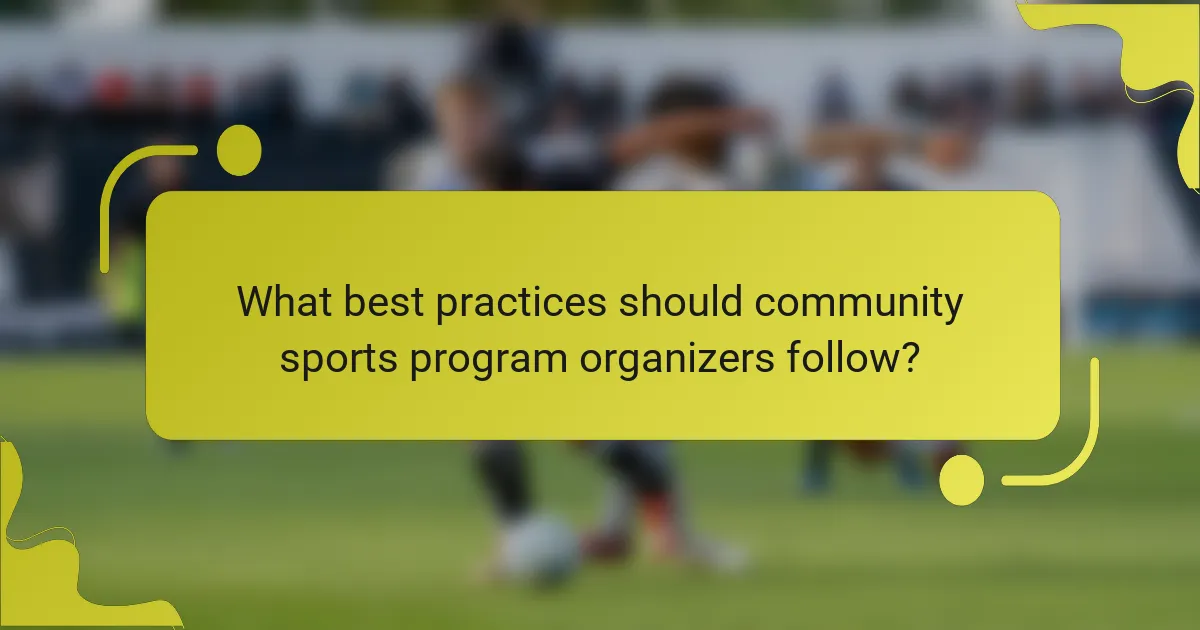
What best practices should community sports program organizers follow?
Community sports program organizers should prioritize inclusivity, effective communication, and sustainability. Engaging diverse participants fosters a sense of belonging and enhances community ties. Clear communication ensures all stakeholders are informed and involved, while sustainable practices promote long-term success. Regular evaluations and feedback loops help refine strategies, ensuring programs remain relevant and impactful.
How can effective communication strategies improve community engagement?
Effective communication strategies enhance community engagement by fostering trust and participation. Clear messaging and active listening create a sense of belonging. Programs that utilize feedback loops improve responsiveness, leading to higher involvement. For instance, regular surveys can gauge community interests, allowing tailored activities that resonate with members. This adaptability increases attendance and satisfaction, showcasing successful community sports programs.
What are the most impactful ways to involve volunteers in programs?
Engaging volunteers in community sports programs can significantly enhance participation and success. Effective strategies include creating clear roles, providing training, and fostering a sense of community.
1. Define roles and responsibilities to align volunteer skills with program needs.
2. Offer training sessions to equip volunteers with necessary skills and knowledge.
3. Foster a community atmosphere through team-building activities and regular communication.
4. Recognize and celebrate volunteer contributions to boost morale and retention.
5. Utilize social media and local events to recruit and engage potential volunteers.
These strategies build a strong volunteer base, leading to more impactful community sports initiatives.
How can program organizers adapt to changing community needs?
Program organizers can adapt to changing community needs by actively engaging with local residents and assessing their preferences. Regular surveys and feedback sessions can reveal emerging interests and challenges.
Incorporating diverse sports and activities ensures inclusivity, fostering participation across age groups and skill levels. Collaborating with local schools and organizations can enhance resource sharing and community involvement.
Flexibility in scheduling and program structure allows for quick adjustments based on attendance trends and seasonal shifts. Emphasizing health and wellness benefits can attract more participants, aligning programs with community priorities.
Success stories from similar programs can serve as inspiration, showcasing effective strategies that resonate with community members.
